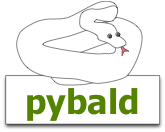Quick Start¶
Installing¶
Using virtualenv¶
While not strictly necessary, it is recommended that you use virtualenv to allow you to isolate experimenting with Pybald (and its dependencies) from the rest of your python environment.
First we setup a new virtualenv, activate it, then we install pybald.
~$ virtualenv pyb_test
New python executable in pyb_test/bin/python
Installing setuptools............done.
Installing pip...............done.
~$ source ./pyb_test/bin/activate
(pyb_test)~$ pip install pybald
Downloading/unpacking pybald
Downloading pybald-X.X.X.tar.gz
Running setup.py egg_info for package pybald
[...]
Successfully installed [various packages]
Cleaning up...
Without virtualenv¶
Just install pybald from pypi using pip.
~$ pip install pybald
Downloading/unpacking pybald
Downloading pybald-X.X.X.tar.gz
Running setup.py egg_info for package pybald
[...]
Successfully installed [various packages]
Cleaning up...
Running your first Pybald Application¶
First copy the following code and save it as a file, say sample.py. Don’t choose the name ‘pybald.py’ since it will conflict with the pybald library name but most any other name should be fine.
import pybald
from pybald import context
from pybald.core.controllers import Controller, action
from pybald.core.router import Router
# configure our pybald application
pybald.configure(debug=True)
def map(urls):
urls.connect('home', r'/', controller='home')
class HomeController(Controller):
@action
def index(self, req):
return "Hello!"
app = Router(routes=map, controllers=[HomeController])
if __name__ == "__main__":
context.start(app)
To start the application from the command line type python sample.py console which starts the pybald console for this project. The pybald console is a standard python REPL but also initializes your project, loads the application code, and allows you to interact with your application in various ways including simulating requests, exploring models, prototyping new functionality, running a debugger and other tasks. The console also has some convenience functions, like saving a per-project history to allow “up arrow”, tab completion and other history searches.
Note
If, instead, you’d like to try the application from a web browser, you can also call python sample.py serve and that will run a simple development web server that you can connect to. You can see a simple help message for command line arguments by using python sample.py -h or python sample.py {COMMAND} -h.
It can be generally useful to be able to explore and introspect the application from a REPL to really learn how Pybald works.
It’s also important to note that the application that runs in the console is exactly the same as the application that runs when connected to the web server.
$ python sample.py console
Route name Methods Path
home /
Welcome to the Pybald interactive console
** project: sample.py **
>>>
When debug logging is turned on, the routing layer of Pybald will display all of the configured url routes for the project, then a small welcome message. In this case, we’ve only set up a single route for ‘/’ connected to the home controller.
The console also loads a very simple testing / convenience client c that allows you to issue simulated web requests to your application using GET’s and POST’s.
$ python sample.py console
Route name Methods Path
home /
Welcome to the Pybald interactive console
** project: sample.py **
>>> resp = c.get('/')
====================================== / ======================================
Method: GET
action: index
controller: home
>>> print resp
200 OK
Content-Type: text/html; charset=utf-8
Content-Length: 6
Hello!
Here we’ve fetched the “/” url from the application and received a response. You can see some debug information is printed to the screen about what URL we fetched, what method and what controller and action were matched/invoked. If any capture variables had been present, they would have been printed as well. Finally we print the response from that request which is the full web response (headers etc) and the simple text response message of “Hello”. The resp object that is returned is an instance of a WebOb Response object. WebOb response objects have numerous useful attributes and methods. For example, you can get things like resp.headers, resp.status, resp.body to see some of the data available on the response.
>>> resp.headers
ResponseHeaders([('Content-Type', 'text/html; charset=utf-8'), ('Content-Length', '6')])
>>> resp.status
'200 OK'
>>> resp.body
'Hello!'
Boom! You’re running a pybald application.
Note
Most of the time you won’t need to know or care, but an interesting detail worth mentioning at this point is that the response object is also a WSGI application just like the core pybald application. This allows for some interesting flexibility in chaining and re-routing application behavior. The response object will accept environ, start_response call signature just like the Router or any other WSGI app. Many of the interfaces of Pybald use the WSGI interace allowing for a great deal of flexibility.
